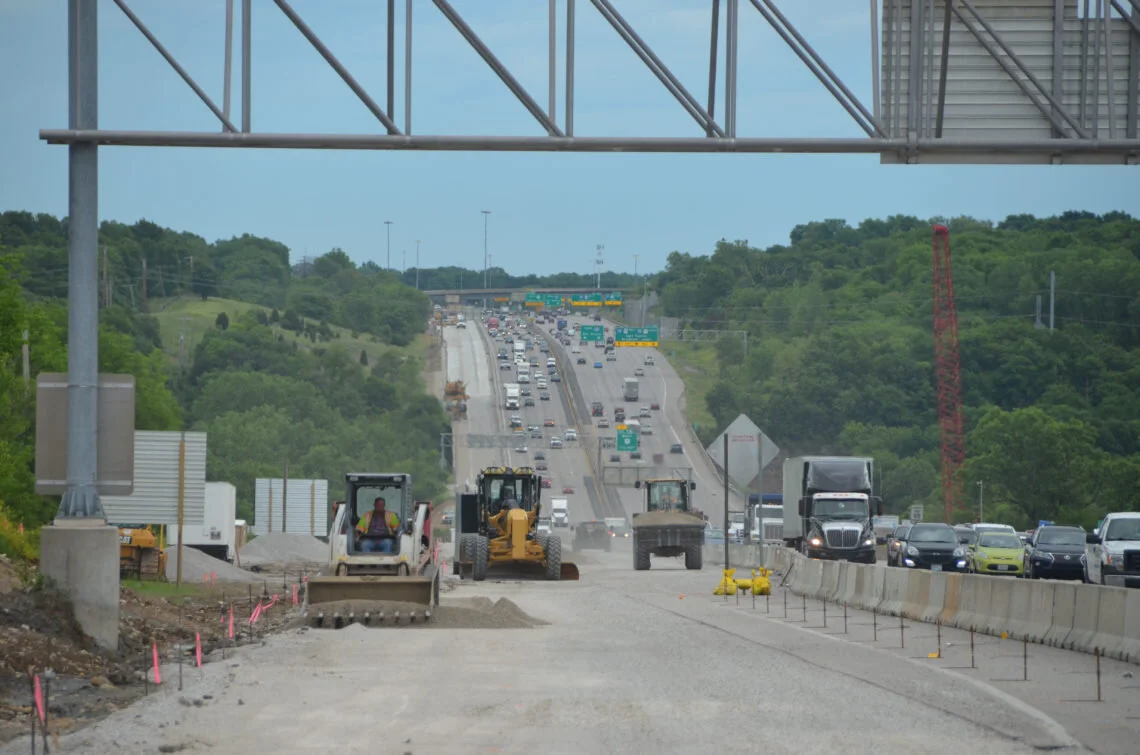This month the Kansas City chapter of DBIA-MAR presented its ‘2020 Project of the Year’ to the project team in charge of the recent reconstruction of the south loop portion of I-435, one of the most heavily traveled corridors in the Kansas City metro area.
Project team members Nicholas Thomas, PE, vice president with Wilson & Company, Inc.; Tawn Nugent, PE, associate partner with TREKK Design Group, LLC; and Ben Cummings, PE, construction manager with Radmacher Brothers Excavating, joined Perry Allen, PE, assistant district engineer with the Kansas City district of the Missouri Department of Transportation (MoDOT), to discuss the award-winning project during DBIA’s monthly breakfast event.
The Missouri portion of the I-435 south loop corridor was first constructed in 1966 as a six lane interstate, with three lanes in each direction.
As volume increased, straining the road’s capacity, Allen said MoDOT added a fourth lane to the inside median and widened existing structures in 1994.
Thereafter, MoDOT provided routine maintenance to the structures and pavement, widening the bridges as needed, but the maintenance cycles became shorter and shorter. The pavement, laid in 1966 and 1994, had been resurfaced, but it was time to replace it.
Capacity along the corridor reached 155,000 vehicles per day. The corridor had the worst safety record for crash incidents and was ranked the second most congested interstate corridor in the Kansas City metro area, behind only I-35 in Kansas. Because there was no inside shoulder large enough to provide refuge, one crash along the corridor closed three lanes of traffic, Allen said.
“You have this combination of things. You have bridges timing out, needing to go through a rehab cycle. You have a safety and congestion issue. You have a durability issue,” said Allen.
With standard rehabilitation projects, MoDOT closes one lane during construction. Because this project was projected to cover four construction seasons, MoDOT recognized that there would be driver fatigue, customer dissatisfaction and safety issues to consider.
“So we moved to evaluating it as a design build job. That was a lot of talking and a lot of taking all the pieces of the puzzle and having them all slide together and identify this corridor needs to be addressed as a corridor,” Allen said.
Prior to issuing a request for proposals (RFP), MoDOT developed goals for the project and budgeted a total of $74.8 million, with $64.5 million allocated to construction.
Allen said one priority goal was to maintain as many lanes as possible during construction and minimize impacts to the traveling public. Other goals included delivering the project on budget by May 1, 2020, using a diverse workforce, maximizing safety and peak travel period speeds and minimizing future maintenance needs.
MoDOT also established mandatory configuration requirements for the corridor project: reconstruct bridges over Wornall and Holmes roads; replace the deck and rehabilitate the bridge over 104th Street; provide a new riding surface; improve mobility and safety; and construct a new sidewalk along State Line Road (which was the only major crossing lacking a pedestrian facility).
MoDOT met one on one with the design build teams who responded to the RFP, with the meeting focused on the established goals. Allen said three teams submitted design build proposals which met MoDOT criteria, and MoDOT selected the Radmacher-Wilson team and its proposed concept.
The Radmacher-Wilson team proposed putting a concrete overlay over the existing pavement, rather than ripping out the pavement and replacing it. Thomas said this set their team apart and it helped to maintain traffic. Cummings said using the concrete overlay also reduced the cost.
The project, a 3.5 mile stretch running from State Line Road to the Three Trails Crossing interchange, commenced in 2017 on a very intense schedule.
“The key was to keep Radmacher working,” said Nugent.
Nugent said everyone on the team had specific roles, and that allowed the team to streamline the process. It also was convenient that the offices Wilson & Company, TREKK and MoDOT were located nearby.
“In the end of it all, not only did design build bring us a much faster delivery, it also provided us a lot more value. As an owner’s rep, when you’re opening up the proposals when they’re delivered after the silent period between the last one on one and the delivery of the project, you’re going oh, what am I going to get. I know what my deal breakers are. This one was a Christmas present. From my perspective, it definitely stepped above any minimums and really took care of the traveling public,” said Allen.

